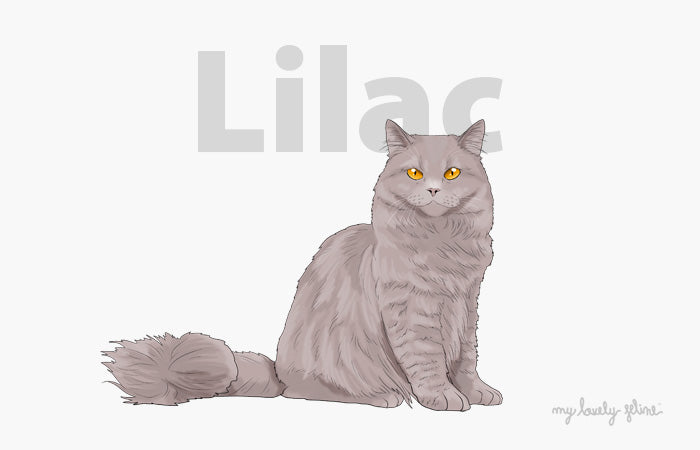—Feline Behavior Specialist 🇺🇸
|
Lilac or lavender cats are not purple as their name indicates, but it is a very light color, almost dusty. This color is extremely rare from a genetics stand point, even in pedigree cats. Let’s talk about what gives cats this beautiful color, along with some other fascinating facts. |
What is a lilac cat?
A lilac cat is a light version of a chocolate-colored cat, and it’s considered one the rarest cat color.
Why is it named lilac or lavender if it isn’t purple?
The undercoat has a pinkish undertone to it that can be noticeable in certain light. Typically, the cat’s nose and paw pads are also a lilac-pink. Other ways lilac cats have been described are light taupe gray, frost, or dove.
Is lilac a breed?
No, it’s a color. Many breeds recognize the lilac color, including Thai Lilac, Burmese, Siamese, American Bobtail, American Curl, Balinese, Bengal, Japanese Bobtail, Lykoi, Oriental, Persian, Himalyan, and Ragdoll.
What genetically determines a cat will be lilac?
The two colors all cats originate from are orange and black (white is something completely different from a genetics perspective). The black color has recessive variations, which turn the black to chocolate.
There is another gene that tells the color to be dense or dilute. If a cat is chocolate and also carries the dilute gene, the result is the chocolate is lighted to a point that the cat is lilac (or lavender).
The reason this color is so rare is because a cat must inherit the recessive chocolate gene from both parents and the recessive dilute gene. Statistically, that’s obviously less likely which is why it’s so rare to see these kitties.
Are lilac cats striped or solid?
They can be either, but they are more commonly solid because of the breeds where they most often appear.
Is there such a thing as a lilac tortie?
Yes! These torties will have lilac along with cream. Since they carry the dilute gene, which turns chocolate brown to lilac, it also turns red to cream.
Is it true that the lilac color wasn’t always recognized as a rare trait?
Yes. For a long time, it was considered a poorly colored version of gray or blue, which is a diluted black color. It took time for people to realize it was actually diluted chocolate.
What’s so special about the Thai Lilac breed?
Thai Lilac cats happened naturally, and without human intervention through breeding … sort of. Humans were breeding Korats (Korat in Thai means “blue cat”), and suddenly, a little pinkish lilac kitten showed up.
They slowly began popping up, and a new breed was born, thanks to the recessive genes of the Korat.
Since they are related to the Korat breed, Thai Lilac cats carry many of the same characteristics. They are extremely social, vocal, and curious. Like many other social breeds, they require a lot of playtime and attention, so this breed wouldn’t be a good fit for someone who isn’t home a lot.
Are there any diseases that seem to be genetically tied to lilac cats?
No, there aren’t. According to Merck Veterinary Manual, the most commonly reported congenital and inherited defects in cats in general are:
- Cerebellar hypoplasia (CH) aka Wobbly Kitten Syndrome - Underdeveloped cerebellum (which controls mobility and balance)
- Eye and eyelid defects
- Heart defects
- Cryptorchidism - One or both testicles absent
-
Polydactyl - Extra toes
In Closing
The rarity of lilac cats only adds to their beauty.
Sources:
CatTime.com, Thai Lilac.
Fanciers, Cat Colors FAQ: Cat Color Genetics.
FAQCats.com, So Are Tabby Cats Really That Rare?.
Finaly, Katie. IHeartCats.com, 7 Rare Cat Coat Colors.
FelineLiving.net, Lilac Point Siamese.
Article by Elizabeth Italia 🙋♀️
Cat Behavior & Fostering Specialist



